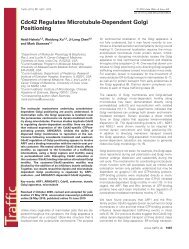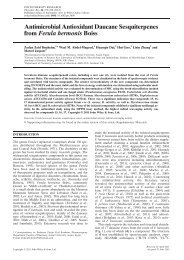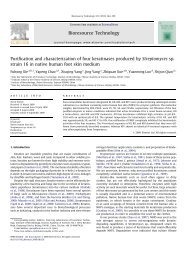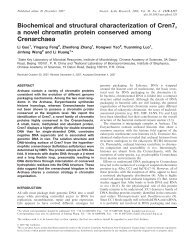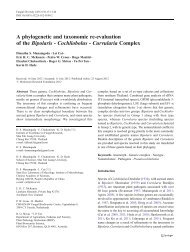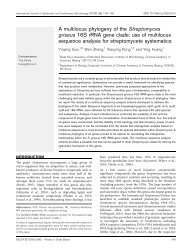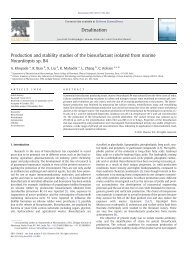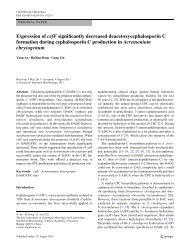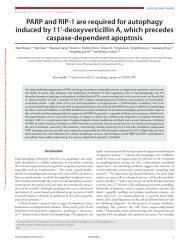Structure and Cleavage Specificity of the Chymotrypsin-Like Serine ...
Structure and Cleavage Specificity of the Chymotrypsin-Like Serine ...
Structure and Cleavage Specificity of the Chymotrypsin-Like Serine ...
Create successful ePaper yourself
Turn your PDF publications into a flip-book with our unique Google optimized e-Paper software.
ARTICLE IN PRESS<br />
2 <strong>Structure</strong> <strong>and</strong> Characterization <strong>of</strong> PRRSV 3CLSP<br />
9 Beijing Institutes <strong>of</strong> Life Science,<br />
Chinese Academy <strong>of</strong> Sciences,<br />
Lincui East Road, Beijing<br />
100101, China<br />
Received 7 May 2009;<br />
received in revised form<br />
19 July 2009;<br />
accepted 22 July 2009<br />
Edited by R. Huber<br />
Keywords: PRRSV; 3C-like serine protease; structure; trans/cis cleavage<br />
Introduction<br />
Porcine reproductive <strong>and</strong> respiratory syndrome<br />
virus (PRRSV) was first discovered in North America<br />
in 1987 1,2 <strong>and</strong> almost simultaneously (in 1990) in<br />
Europe. 3 It manifests itself clinically with severe<br />
reproductive failure in sows <strong>and</strong> respiratory distress<br />
in neonatal pigs. 2 In recent years, <strong>the</strong> virus has<br />
become endemic throughout <strong>the</strong> world, leading to<br />
significant economic losses in pig production. 4 In <strong>the</strong><br />
autumn <strong>of</strong> 2006, unparalleled outbreaks <strong>of</strong> atypical<br />
PRRS occurred in more than 10 provinces (or<br />
autonomous cities) <strong>of</strong> China, affecting more than 2<br />
million pigs with nearly 400,000 fatal cases. Adult<br />
<strong>and</strong> growing pigs were also affected, which was<br />
different from classical PRRS. 5 In 2007, an almost<br />
identical atypical PRRSV was found to be epidemic<br />
in Vietnam <strong>and</strong> China. 6 Presently, only inactivated<br />
or attenuated vaccines are available to combat PRRS,<br />
but <strong>the</strong>ir efficacy is less than satisfactory due to<br />
adaptive evolution <strong>of</strong> PRRSV, 7,8 especially in <strong>the</strong><br />
cases <strong>of</strong> <strong>the</strong> atypical PRRS outbreaks in China <strong>and</strong><br />
Vietnam. 5,6 This urgent issue prompted us to exploit<br />
<strong>the</strong> possibility <strong>of</strong> drug discovery for treatment <strong>of</strong> <strong>the</strong><br />
highly pathogenic PRRSV infection.<br />
<strong>Like</strong> o<strong>the</strong>r RNA viruses in <strong>the</strong> order Nidovirales,<br />
such as equine arteritis virus (EAV), human coronavirus<br />
229E, <strong>and</strong> severe acute respiratory syndrome<br />
coronavirus (SARS-CoV), PRRSV has a singlestr<strong>and</strong>ed<br />
positive-sense RNA genome that is about<br />
15.3 kb in size, containing a large 5′-terminal<br />
replicase gene <strong>and</strong> a downstream set <strong>of</strong> structural<br />
protein genes. 9 The replicase gene is translated into<br />
two large polyprotein precursors, 1a <strong>and</strong> 1ab (with<br />
molecular masses <strong>of</strong> about 269.1 <strong>and</strong> 430.3 kDa for<br />
pp1a <strong>and</strong> pp1ab, respectively), with <strong>the</strong> latter being<br />
syn<strong>the</strong>sized following a ribosomal frame-shifting<br />
event. 10 After <strong>the</strong> rapid autocatalytic release <strong>of</strong><br />
nonstructural protein 1 (nsp1) <strong>and</strong> nsp2, <strong>the</strong> remainder<br />
<strong>of</strong> <strong>the</strong> polyproteins are cleaved into 10 mature<br />
nonstructural proteins (nsp3–nsp12) by <strong>the</strong> 3C-like<br />
serine protease (3CLSP), which is also <strong>of</strong>ten simply<br />
called 3C-like proteinase (3CL pro ). 9,11 The functional<br />
importance <strong>of</strong> <strong>the</strong> 3CL proteinase in <strong>the</strong> viral life<br />
cycle makes it an attractive target for <strong>the</strong> development<br />
<strong>of</strong> drugs directed against PRRSV.<br />
Here, we confirm that PRRSV nsp4, which we<br />
demonstrate to extend from residue G1780 to E1983<br />
in <strong>the</strong> viral polyprotein <strong>of</strong> <strong>the</strong> virus strain JXA1, is a<br />
3CLSP from both <strong>the</strong> structural <strong>and</strong> enzymatic<br />
points <strong>of</strong> view. The structure <strong>of</strong> <strong>the</strong> enzyme reveals<br />
two chymotrypsin-like β-barrel domains <strong>and</strong> an<br />
extra C-terminal α/β domain similar to that<br />
observed in EAV nsp4. 12 A canonical catalytic<br />
triad that is composed <strong>of</strong> Ser118, His39, <strong>and</strong><br />
Asp64 is located in <strong>the</strong> open cleft between <strong>the</strong> two<br />
β-barrel domains. An S1 subsite consisting <strong>of</strong><br />
His133 <strong>and</strong> very likely Ser136 <strong>and</strong> an oxyanion<br />
hole without <strong>the</strong> signature helix-like turn are seen in<br />
our structure. Our results also clearly show that <strong>the</strong><br />
recombinant enzyme displays proteolytic activity in<br />
vitro. Besides, based on <strong>the</strong> results <strong>of</strong> <strong>the</strong> cleavage<br />
assay, three nsp junction sites in <strong>the</strong> PRRSV replicase<br />
precursor are confirmed, <strong>the</strong>reby shedding<br />
light on <strong>the</strong> processing pathway <strong>of</strong> pp1a <strong>and</strong> pp1ab<br />
in <strong>the</strong> virus.<br />
Results<br />
Overall description <strong>of</strong> <strong>the</strong> recombinant PRRSV<br />
3CLSP used in this study<br />
As a member <strong>of</strong> <strong>the</strong> Arteriviridae, PRRSV shows<br />
substantial similarities in genome organization to<br />
EAV—<strong>the</strong> prototype virus <strong>of</strong> this family. 13–15<br />
Accordingly, whole genome bioinformatics analysis<br />
predicts that <strong>the</strong> PRRSV nsp4 domain should be <strong>the</strong><br />
main protease responsible for processing most <strong>of</strong><br />
polyproteins pp1a <strong>and</strong> pp1ab. 15 Previously, we<br />
reported on <strong>the</strong> successful expression <strong>of</strong> a gene<br />
construct encoding this putative serine protease in<br />
Escherichia coli as well as <strong>the</strong> crystallization <strong>of</strong> <strong>the</strong><br />
protein. 16 As shown in Fig. 1a, after removal <strong>of</strong> <strong>the</strong><br />
glutathione S-transferase (GST) tag, nine additional<br />
amino acid residues were still left at <strong>the</strong> N-terminus<br />
<strong>of</strong> <strong>the</strong> protein. The in vitro peptide cleavage assay in<br />
this study was performed using this recombinant<br />
enzyme with <strong>the</strong> nine extra residues present, while<br />
for <strong>the</strong> cis cleavage assay, even more additional N-<br />
terminal residues were present (Fig. 1b). In both<br />
cases, <strong>the</strong> recombinant protein displayed proteolytic<br />
activity in vitro, <strong>the</strong>reby confirming <strong>the</strong> identity <strong>of</strong><br />
nsp4 as <strong>the</strong> main protease in PRRSV replication (see<br />
results below).<br />
Please cite this article as: Tian, X., et al., <strong>Structure</strong> <strong>and</strong> <strong>Cleavage</strong> <strong>Specificity</strong> <strong>of</strong> <strong>the</strong> <strong>Chymotrypsin</strong>-<strong>Like</strong> <strong>Serine</strong> Protease (3CLSP/nsp4)<br />
<strong>of</strong> Porcine Reproductive <strong>and</strong> Respiratory Syndrome Virus (PRRSV), J. Mol. Biol. (2009), doi:10.1016/j.jmb.2009.07.062





